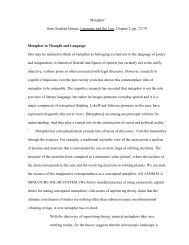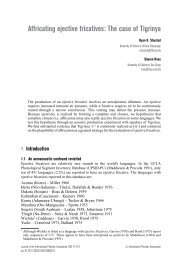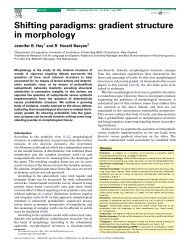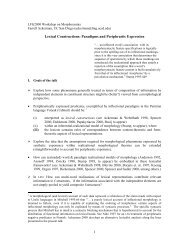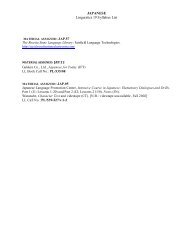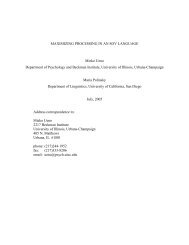The morphological structure of the Moro verb Sharon Rose
The morphological structure of the Moro verb Sharon Rose
The morphological structure of the Moro verb Sharon Rose
Create successful ePaper yourself
Turn your PDF publications into a flip-book with our unique Google optimized e-Paper software.
6.3 <strong>The</strong> causative suffix -i<br />
<strong>The</strong> <strong>morphological</strong> <strong>structure</strong> <strong>of</strong> <strong>the</strong> <strong>Moro</strong> <strong>verb</strong><br />
As noted above, <strong>the</strong> causative vowel combines with <strong>the</strong> final aspect/mood<br />
vowel ra<strong>the</strong>r than preceding it if <strong>the</strong>re are no additional extension suffixes<br />
intervening. In addition, <strong>the</strong> causative imposes a particular tone pattern that<br />
<strong>the</strong> o<strong>the</strong>r extension suffixes do not. As discussed in Strabone & <strong>Rose</strong> (to<br />
appear), <strong>the</strong> causative requires a H tone on <strong>the</strong> preceding stem in default<br />
tone constructions, and allows no H tone on <strong>the</strong> causative marker. For long<br />
<strong>verb</strong>s, this does not alter <strong>the</strong> basic tone pattern, but for short <strong>verb</strong>s, it does,<br />
as shown below:<br />
(44) ROOT TONE PROXIMAL TONE CAUSATIVE PROXIMAL<br />
SHAPE IMPERFECTIVE IMPERFECTIVE<br />
a. CVC H-H g-a-ðə́w-á H-L g-ʌ-ðə́w-iə poke<br />
g-a-lág-á g-ʌ-lʌ́g-iə weed<br />
b. Cː L-L g-a-s:-a H-L g-ʌ́-s:-iə eat<br />
c. VC L-L g-al-a H-L g-ʌ́l-iə slice<br />
g-oað-a g-uʌ́ð-iə mill, grind<br />
<strong>The</strong> tone pattern in <strong>the</strong> causative consists <strong>of</strong> L tone on <strong>the</strong> causative<br />
proximal imperfective suffix, and a preceding H tone on <strong>the</strong> root or <strong>the</strong><br />
clause marker preceding it, if <strong>the</strong>re is no root vowel.<br />
Vowel harmony is observed with <strong>the</strong> causative, and it also triggers<br />
palatalization <strong>of</strong> a preceding dental stop. In <strong>the</strong>se examples, <strong>the</strong> melodic<br />
tone pattern is carried over to <strong>the</strong> causative.<br />
(45) PERFECTIVE CAUSATIVE PERFECTIVE<br />
a. g-a-təŋat ̪-ó g-ʌ-təŋʌʧ-í lick<br />
b. g-a-dogat ̪-ó g-ʌ-dugʌʧ-í repair<br />
c. g-a-rəm w ət ̪-ó g-ʌ-rəm w əʧ-í take care <strong>of</strong><br />
d. g-ogət ̪-ó g-ugəʧ-í jump<br />
e. g-a-land̪-ó g-ʌ-lʌnʤ-í close<br />
<strong>The</strong> causative follows <strong>the</strong> anti-passive/reciprocal/distributive and <strong>the</strong><br />
locative applicative marker, as seen in <strong>the</strong> following examples. <strong>The</strong> causative<br />
combines with <strong>the</strong> final aspect/mood vowel, raises vowels and causes<br />
palatalization <strong>of</strong> <strong>the</strong> dental stop <strong>of</strong> <strong>the</strong> locative applicative in (46b). This<br />
example also shows that <strong>the</strong> AP suffix -əð precedes <strong>the</strong> locative applicative.<br />
(46) a. k-ʌ-mə́g-ə́ð-iə lidʒí<br />
s/he is putting a curse on <strong>the</strong> people<br />
b. k-ʌ-mə́g-ə́ð-ʌtʃ-iə ówːá lidʒí é-lná<br />
s/he is putting a curse on <strong>the</strong> people in <strong>the</strong> room<br />
23







